Mondays Trip
Before we get started a little humor:

Busted -the two cleaning ladies (the button breaker on the left, the mikva lady on the right) taking a smoking break on our front porch.
As I reported the other day we went on a trip to Majdanek/Lublin (Does not rhyme with Dublin). Note: those pictures with a star next to them were taken by Yankel Adler (see Yankel -I told you that you'd get credit)
*


The Van
Our first stop was a small shtetl known Kazimrz (Pronounced Kazhim'sh, known by the Jews as Kuzmir (which sounds a lot like Kush Mir . . .)) It still is in many respects a shtetl -on the way there we saw a guy plowing his field with a horse!
Our first stop was the Beis Hak'varos (the Graveyard)

The entrance to the cemetery in Kazimrz the Grave stones were those broken by the Germans and redone as a memorial
Most of the Metzvos (Head Stones) were destroyed, but several could be found standing. Notice the intricately engraved on the stones.

Fallen Matzevos
After we left our tour guide, Thomas (who, though not Jewish, speaks Hebrew and Yiddish -as well as English), took us to the town square -where most of the shops had once been Jewish.

The town square
We took a group picture there:

We saw the old shul -it had been used as a theatre during Communist times, but was now being restored and then set off on our way . . .
Note: Some people are very disturbed by pictures etc. Of Concentration camps. If viewing/reading will bring discomfort, please don't let it be on my account, I advise you to skip ahead until you see the next set of Bold letters.
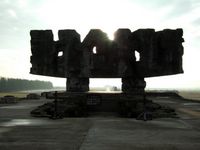
Our first stop in the Lublin area was Majdanek (Pronounced Maydanek -If you haven't heard of it, it's time to do some basic Holocaust reading). Though it was once out in the country, it's now in the middle of the suburbs surrounded by house on two sides.

"Entrance to Hell." One feels himself slowly descending, only to realize that escape is almost impossible.

a view of part of the camp
Some Basic History:(taken from Wikipedia) Majdanek is the site of a Nazi concentration and extermination camp, roughly four kilometers away from the center of the Polish city Lublin. Unlike many other Nazi concentration and extermination camps, Majdanek is not hidden away in some remote forest or obscured from view by natural barriers, nor was it surrounded by a "security zone". It was established in October 1941, at Heinlich Himmler's orders, following his visit to Lublin in July 1941. Majdanek was an SS-run prisoner-of-war camp, under the command of Karl Otto Koch. In February 1943, it was turned into a concentration camp.
In October 1942, several female SS troopers arrived from the Ravensbruck camp in Germany, where they were trained. These women included Elsa Erich, Hermine Braunsteiner, Hildegard Lachert and Rosy Suess. Elisabeth Knoblich was one of the ruthless overseers in the camp. She was so brutal and sadistic that even her fellow Aufseherinnen feared her and nicknamed her "Halt Die Klappe" (Shut Your Mouth!). When the Soviets liberated Majdanek, they found unending evidence that pointed to the ruthless attitude of the female overseers.
The camp's name derives from a Lublin district called Majdan Tatarski, and was given it in 1941 by the locals, who were certainly aware of its existence. The original German name of the camp was "Konzentrationslager Lublin" (Concentration Camp Lublin).
At its peak operation, it held about 50,000 inmates. In the early months of 1942, plans were made and approved to expand Majdanek to contain as many as 250,000 inmates. Between April 1942 and July 1944, extermination took place in Majdanek using gas chambers and crematoria. Madjanek was one of two death camps that used Zyklon B in its gas chambers. However, carbon monoxide was also used.
According to the data from the official Majdanek State Museum (see external link below) about 300,000 inmates passed through the camp, with over 40% Jews and about 35% Poles. Other major nationalities included Belarusians, Ukrainians, Russians, Germans, Austrians, French, Italians and Dutch. It is estimated that over 235,000 human lives were lost in Majdanek, including about 100,000 Jews. Majdanek was unique among the death camps in that the Jewish victims did not form an overwhelming majority.
Majdanek provided slave labor for munitions works and the Steyr-Daimler-Puch weapons factory.
The camp was liquidated in July 1944, but the crematoria were all that could be destroyed before the Red Army arrived, making Majdanek the best-preserved camp of the Holocaust. Although 1,000 inmates were evacuated on a death march, the Red Army found thousands of inmates, mainly POW, still in the camp and ample evidence of the mass murder that had occurred there.
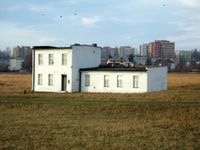
The Hospital for the German Officers

The Lodgings for the SS men.
We then came to the Roll Call grounds, where people were brought when they first arrived, and divided . . .

The chambers, labeled as Baths (so as to calm the victims), at the time they were in use the place was full of roses as well -so as to further deceive those entering Majdanek.

Next were the shower rooms, after shaving off the hair of those about to be murdered (the hair was used to to defray the cost of buying zyklon b), they were herded into the showers so as to calm them (to allay their fears that they were to be killed) and to open the pores in the skin so that the gas can better enter the body.

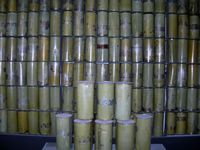
the walls of the chambers, dyed blue by the Zyklon B. Zyklon B
As mentioned, Majdanek is one of the best preserved Concentration camps, however after the war the Poles were in acute need of housing, they therefore broke down three of the four "fields" -bunker units, as well the the dog kennels and other parts of the camp.
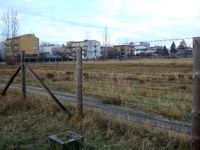
The foundations of a building, notice how today people now live right outside of the camp.
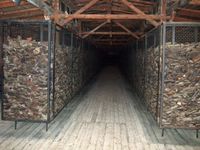 After the war there were over 80,000 shoes left from those murdered. 60,00 were stolen by the poles for their own use -the rest are now on display.
After the war there were over 80,000 shoes left from those murdered. 60,00 were stolen by the poles for their own use -the rest are now on display.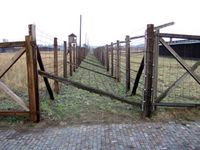

The double barbed wire electric gates.
We then entered the only remaining field, where the inmates lived.

A monument made by inmates on request of the officers so that if the Red Cross were to come the camp would look more hospitable. The artists hid a canister of ashes within the monument -so that it would also serve as a sign of the atrocities that the Germans had done.
We then went to the back of the camp to the most horrid place that I've ever been . .

The camp is full of crows -our guide said that they were the SS and Kapos, come back to spend their lives in their horrid camp. Though I don't know it to be true, it certainly is poetic justice.
*

Approaching the "new" gas chamber/crematorium and mausoleum where 20 containers of human ashes left over by Germans were placed by the Russians as a testimony to the world. It says on it (in Polish) "Let our fate be a warning."
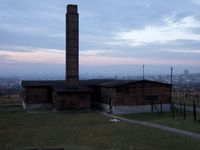
The "new" Gas chamber/Crematorium built during the second half of the war near the back of the camp.


the Gas Chambers A table used to dissect victims who might have swallowed valuables

The Bathtub that belonged to the head Officer, it was heated by the crematorium


Light entry the crematorium Some pictures need no caption

Though these roses are new, it is known that ash from the crematorium was used to fertilize the flowers.

We then went to the mausoleum, passing the mass graves, of 18,400 Jews killed in Majdanek on November 3. That day a total of 42,000 Jews were murdered in the Lublin area. The Germans later dug up the bodies and burned them so that the Russians would not be able to know the exact number of those murdered.
*

We davened Mincha and sang Al Tira: Do not fear sudden terror, nor the destruction of the wicked when it comes. Contrive a scheme, but it will be foiled; conspire a plot, but it will not materialize, for G-d is with us. To your old age Ia am [with you]; to your hoary years I will sustain you; I have made you, and I will carry you; I will sustain you and deliver you.
Indeed, the righteous will extol Your Name; the upright will dwell in Your presence.
On to Lublin:

The Ohel of Reb Tzadok haCohen, Reb Leibele Eiger and his family, in the new Lublin Cemetery. Of the four original cemeteries, two were completely destroyed, and part of the new one was paved over for a road. We then went to the old Bais Hak'varos

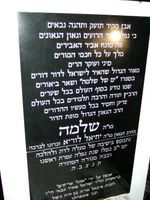
Inside the Choze's Ohel The Maharshal's Ohel
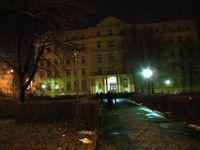
Yeshivas Chachmie Lublin (Taken using Chaim van Helem's head as a tripod)
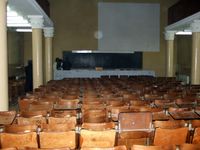
The Zal

The Mikvah
We then went to the old city -Jewish quarter
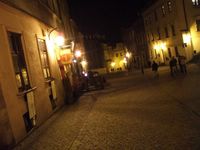
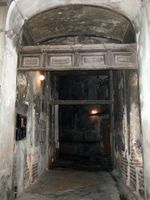
A ghetto house
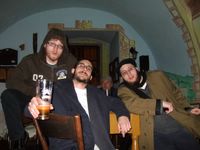
taking a break in a "Jewish" restaurant

an old lady in the old town

The Town square (Jews were not allowed there)
We then returned to Yeshiva.

0 Comments:
Post a Comment
<< Home